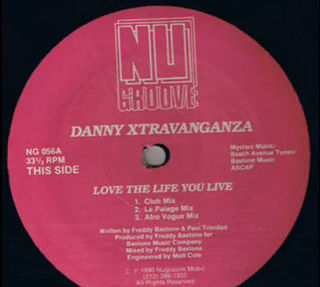
Vogue, or voguing, is a highly stylized, modern house dance originating in the late 1980s that evolved out of the Harlem ballroom scene of the 1960s. It is inspired by the poses of models in fashion magazines.

Paris Is Burning is a 1990 American documentary film directed by Jennie Livingston. Filmed in the mid-to-late 1980s, it chronicles the ball culture of New York City and the African-American, Latino, gay, and transgender communities involved in it.

William Roscoe Leake, better known as Willi Ninja, was an American dancer and choreographer known for his appearance in the documentary film Paris Is Burning.

Venus Xtravaganza was an American transgender performer. She came to national attention after her appearance in Jennie Livingston's 1990 documentary film Paris Is Burning, in which her life as a trans woman forms one of the film's several story arcs.

Jennie Livingston is an American director best known for the 1990 documentary Paris is Burning.

The Ballroom scene is an African-American and Latino underground LGBTQ+ subculture. Its origins can be found in drag balls of the mid-19th century United States, such as those hosted by William Dorsey Swann, a formerly enslaved Black man in Washington D.C.. By the early 20th century, integrated drag balls were popular in cities such as New York, Chicago, New Orleans, Baltimore, and Philadelphia. In the mid-20th century, as a response to racism in integrated drag spaces, the balls evolved into house ballroom, where Black and Latino attendees could "walk" in a variety of categories for trophies and cash prizes. Most participants in ballroom belong to groups known as "houses," where chosen families of friends form relationships and communities separate from their families of origin, from which they may be estranged. The influence of ballroom culture can be seen in dance, language, music, and popular culture, and the community still exists today.

Angie Xtravaganza was a co-founder and Mother of the House of Xtravaganza. A prominent transgender performer in New York City's gay ball culture, Xtravanganza featured in the acclaimed 1990 documentary film Paris is Burning.

Pepper LaBeija was an American drag queen and fashion designer. She was known as "the last remaining queen of the Harlem drag balls".

Wolfgang Busch is a multiple-award-winning documentary filmmaker, director, producer, cinematographer and editor. He was inducted into the Queens Business Hall of Fame for his company Art From The Heart Films for "Best LGBT Business" and into the LGBT Music Hall of Fame. For his social and artistic activism for the Black and Hispanic LGBT Ballroom community, aka Harlem Drag Ball community, Wolfgang received a Humanitarian award for his documentary How Do I Look, and the "Keep The Dream Alive" Martin Luther King Humanitarian award from the straight Black community.
Kevin Burrus, also known as Kevin UltraOmni is an American mentor, speaker, LGBTQ activist, and film producer who founded the ball culture House of Omni in 1979–which was renamed the House of UltraOmni in 1990–and has chapters across the country. He has become an authority on ball culture and has spoken in interviews about the movement. Omni is also the assistant director for the documentary How Do I Look, produced by Wolfgang Busch which aims to correct misperceptions about ball culture.

Danni Xtravaganza was a founding member of the House of Xtravaganza, the first primarily Latino house in the underground Harlem ball culture.
Founded in 1982, the House of Xtravaganza is one of the most publicly recognized "houses" to emerge from the New York City underground ballroom scene and among the longest continuously active. House of Xtravaganza members and the collective group is recognized for their cultural influence in the areas of dance, music, visual arts, nightlife, fashion, and community activism. House of Xtravaganza members continue to be featured in popular media and travel the world as ambassadors of voguing and the ballroom scene.
"Kiki" is a term which started in ballroom culture and has recently been brought back to slang by the LGBT community, is loosely defined as a gathering of friends for the purpose of gossiping and chit-chat, and later made more famous in the 2012 song "Let's Have a Kiki" by the Scissor Sisters.

Jose Gutierez Xtravaganza is a dancer, choreographer, and recording artist. He is one of the most widely recognized personalities to emerge from the NYC ballroom scene of the 1980s. He is best known for his work with Madonna.

Paris Dupree was an American drag performer and documentary participant featured in Jennie Livingston's 1990 documentary, Paris is Burning, which was named after Dupree's annual ball.

Kiki is an American-Swedish co-produced documentary film, released in 2016. It takes place in New York City, and focuses on the "drag and voguing scene [and] surveys the lives of LGBT youth of color at a time when Black Lives Matter and trans rights are making front-page headlines". The film was directed by Sara Jordenö and considered an unofficial sequel to the influential 1990 film Paris Is Burning, the film profiles several young LGBT people of colour participating in contemporary LGBT African American ball culture.
Hector Xtravaganza was a member of the House of Xtravaganza and well-known figure in the NYC ballroom life, entertainer, fashion stylist, and public advocate for HIV/AIDS and LGBTQ+ organizations.
Luis Camacho is a dancer, choreographer and recording artist. He is best known for his work with Madonna.
Jason A. Rodriguez is a Dominican-American actor and dancer. He is known for his role of Lemar Wintour in the FX television series Pose. He is also known as Slim Xtravaganza and belongs to the House of Xtravaganza, part of the New York City ballroom scene.
Carmen Inmaculada Ruiz, known as Carmen Xtravaganza and formerly as Carmen St. Laurent, was a Spanish-born American model and singer. A house mother of the House of Xtravaganza, she was featured in the 1990 documentary film Paris Is Burning.













